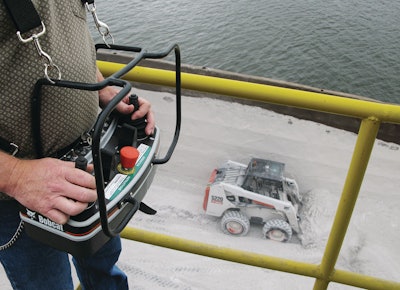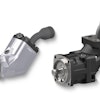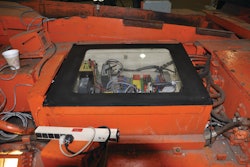
Loader operators who work in applications that require two or more people, or who want to minimize work site environment discomforts, now have a solution — the loader radio remote control system (RRCS) from Bobcat Co.
The system enhances the capabilities of Bobcat skid-steers and compact track loaders with selectable joystick controls and Bobcat all-wheel-steer loaders, offering a simple solution for customers who want to operate their loader remotely.
Operators can start the loader engine and operate the drive, lift, tilt and auxiliary hydraulic functions from approximately 1,500 ft. away with the radio remote control transmitter. The transmitter joystick controls activate the loader's joystick controls in the ISO control pattern. The system is usable for up to 15 hours on a rechargeable battery. In addition to being able to use the system in various climate conditions, operators can easily switch between "remote" control mode and "machine/direct" control mode.
The RRCS will be an attractive option to customers in markets including military, government, construction, landscaping and agriculture. The system will be especially beneficial to the military because of a military mandate that one third of all ground vehicles must be unmanned beginning in 2015. Other possible markets include shipping yards (for ship and barge unloading), nuclear power plants, foundries, mining, chemical plants and municipalities.
Beyond increased productivity and comfort, allowing the operator to be a safe distance away from possibly dangerous situations increases job site safety.
Concrete demolition, asphalt planing, firebreak construction and stump removal are just a few applications in which the RRCS could be used. For many of these applications, a two-person work crew is required. But with the RRCS, one person can complete these tasks while operating the loader using the remote control transmitter from outside the machine.
For example, two people are often required when using planers and wheel saws — one stands outside and helps guide the placement of the attachment using hand signals, while the other operates the loader. When the attachment is in use, the operator is subjected to noise and dust and may need to wear additional personal protective equipment depending on the application. The advantage of the loader RRCS is that one person can now perform the same work while standing at a safe distance from the loader, thus minimizing those job site discomforts and increasing productivity and safety at the same time.
The system, which has a maximum operation loader travel speed of 6.2 mph, is approved for use with dozens of different Bobcat attachments.
The Bobcat loader RRCS is not approved for certain types of hazardous or explosive environments; however, it does allow the operator to be separate from the loader. This can potentially increase productivity, comfort and safety by not subjecting the operator to dusty and noisy environments.
Operators can easily attach the system to remote control-ready loaders. They simply attach the receiver and E-stop box to the machine using magnets, which are included. The harness is then connected, the rear window is removed (or the rear window external removal kit can be installed), attach the remote ready identification tag and the machine is ready to be operated remotely.
The system is portable, so managers with multiple machines in their fleet can quickly transfer the system from one Bobcat loader to another. The loader's internal controllers must be programmed with the correct software version for the RRCS to function correctly. Older loader models may need a software upgrade.
Safety features
The system comes with the Bobcat loader radio remote control operator training course, which offers video, hands-on and classroom training. The course also includes a basic operator training program for beginning operators.
Red-colored emergency stop buttons are located on the transmitter, and an E-stop box is affixed to the rear of the loader. A tilt sensor stops the loader engine if the transmitter is tilted over 45 degrees in any direction, and the transmitter joystick controls have a return to neutral feature.
A transmitter guard bar provides protection against bumping or damaging the control and also connects to shoulder and waist straps to place the transmitter in a comfortable position for the operator.
The system complies with ISO 15817 earthmoving machinery safety requirements for remote operator control.
The transmitter weighs 8.5 lbs. without straps, and its actual transmitting range will vary depending upon work site conditions; however, visual contact with the loader and its travel path is always required. The RRCS transmits on a license-free 2.4 GHz per FCC PART 18 (with interference-free frequency hopping spread spectrum). Transmitter and receiver configurations are factory-set and must be used as matched pairs.


















